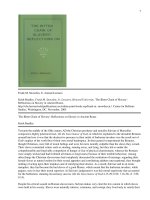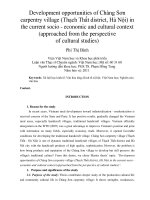Gorgias studies in classical and late antiquity 3 Rachael b goldman color terms in social and cultural context in ancient rome gorgias press (2013)
Bạn đang xem bản rút gọn của tài liệu. Xem và tải ngay bản đầy đủ của tài liệu tại đây (1.88 MB, 205 trang )
Color-Terms in Social and
Cultural Context in Ancient
Rome
Gorgias Studies in Classical and Late Antiquity
3
Gorgias Studies in Classical and Late Antiquity contains monographs
and edited volumes on the Greco-Roman world and its transition
into Late Antiquity, encompassing political and social structures,
knowledge and educational ideals, art, architecture and literature.
Color-Terms in Social and
Cultural Context in Ancient
Rome
Rachael B. Goldman
9
34
2013
Gorgias Press LLC, 954 River Road, Piscataway, NJ, 08854, USA
www.gorgiaspress.com
Copyright © 2013 by Gorgias Press LLC
All rights reserved under International and Pan-American Copyright
Conventions. No part of this publication may be reproduced, stored in a
retrieval system or transmitted in any form or by any means, electronic,
mechanical, photocopying, recording, scanning or otherwise without the
prior written permission of Gorgias Press LLC.
2013
ܛ
9
ISBN 978-1-61143-914-4
Library of Congress Cataloging-in-Publication
Data
Goldman, Rachael.
Color-terms in social and cultural context in
ancient Rome / by Rachael Goldman.
pages cm -- (Gorgias studies in
classical and late antiquity ; 3)
Includes bibliographical references and
index.
ISBN 978-1-61143-914-4
1. Rome--Social life and customs. 2.
Colors--Social aspects--Rome. 3.
Sociolinguistics--Rome. 4. Social
structure--Rome. I. Title.
DG78.G65 2013
306.440937--dc23
2013035963
Printed in the United States of America
TABLE OF CONTENTS
Table of Contents ..................................................................................... v
Acknowledgments .................................................................................. vii
Note on Texts, Translations and Abbreviations ................................ ix
Introduction .............................................................................................. 1
Different Hues, Different Views .................................................. 1
Modern Approaches to Roman Colors ....................................... 3
A Thematic Approach to the Subject .......................................... 7
Chapter One: Aulus Gellius’ Colorful Digression .............................. 9
The Color Debate: Latin Color Terms ...................................... 10
Greek Color-Terms ....................................................................... 18
Fronto and the Roman Artistic Background ............................ 19
Favorinus and Physiognomy ....................................................... 23
Summary ......................................................................................... 24
Chapter Two: Ancient Dyes: Color Me Beautiful ............................. 25
Purple Dyers ................................................................................... 27
Red Dyers ....................................................................................... 31
Other Dyers .................................................................................... 32
Vitruvian Colors ............................................................................ 33
Summary ......................................................................................... 37
Chapter Three: Colored Clothing: You Are What You Wear ......... 39
Purple Colored Clothing .............................................................. 40
Red Colored Clothing ................................................................... 52
Blue and Green Colored Clothing .............................................. 55
Yellow Colored Clothing.............................................................. 57
White, Gray, Black and Brown.................................................... 62
Pullus ................................................................................................ 65
Summary ......................................................................................... 68
Chapter Four: Clothes Make the Man: Class and Color-Terms ..... 71
Trimalchio the Freedman ............................................................. 71
The Freedman’s Wife.................................................................... 76
v
vi
COLOR-TERMS IN SOCIAL AND CULTURAL CONTEXT
The Freedman’s Feast................................................................... 79
Freedmen in Poetry ....................................................................... 80
Summary ......................................................................................... 83
Chapter Five: Color Wars: Roman Chariot Teams ........................... 85
The Setting ...................................................................................... 85
The Teams ...................................................................................... 87
The Greens ..................................................................................... 90
The Blues ........................................................................................ 94
The Reds, Whites and Others ..................................................... 95
Epilogue .......................................................................................... 96
Chapter Six: Color Physiognomy: You Are What You Look
Like .................................................................................................. 99
Descriptions of Emperors .........................................................100
Descriptions of Ordinary Men ..................................................109
Descriptions of Women .............................................................118
Descriptions of Non-Romans ...................................................125
Gauls, Germans, and Britons ....................................................126
Assyrians, Egyptians, Ethiopians, Etruscans and Indians ....130
Summary .......................................................................................133
Chapter Seven: The Multicolored World of the Romans ..............135
Versicolor ........................................................................................135
Decolor and Decolorare....................................................................141
Discolor ...........................................................................................146
Bicolor..............................................................................................151
Multicolor ........................................................................................152
Omnicolor ........................................................................................154
Unicolor and Concolor .....................................................................155
Summary .......................................................................................160
Conclusions: Did Color-Terms Have an Ancient History? ...........161
Bibliography ..........................................................................................165
Index of Latin Color-Terms ...............................................................175
Index of Classical Works Cited ..........................................................179
General Index........................................................................................187
ACKNOWLEDGMENTS
This book began life as a portion of the my Ph.D. Dissertation
written at the City University of New York-Graduate Center, the
American Academy in Rome, and Rutgers University. I would like
to thank those institutions for access to their facilities and for their
financial support. I would especially like to thank the excellent staff
of each of these libraries for getting some of most obscure works I
could ever dream of. Grants from the Association of Ancient Historians and the Classical Association of Atlantic States also made
this work possible. Panels held at the Roman House Workshop at
New York University, American Historical Association and the
Renaissance Society of America helped clarify and brighten some
of the unclear passages.
Having supported myself during my graduate study, I would
also like to thank the following institutions for allowing me to
share all that I know about the ancient world in their classrooms:
The College of New Jersey, Adelphi University, Montclair State
University, Bronx Community College, The Pratt Institute and Union Community College. Students from my Roman Civilization
course helped me form solid ideas about colors and their uses,
while students in the Rome and Barbarians course helped defined
shades for the non-Roman. The best of colleagues!
I would like to extend my thanks to my dissertation advisor,
Jennifer T. Roberts, who advised me and graciously took me as her
student. Further, I must acknowledge others, whom I also regard
to be mentors: Dee L. Clayman, Margaret King, Sarah Covington,
Duane W. Roller, Wladislaw Roczniak, Gary Farney, T. Corey
Brennan, Cindy Nimchuk, Kaius Tuori, Martin Burke, Ann Moyer,
Judith Hallett, Sulochana Asirvatham, Leanne Bablitz, Lisa Mignone, Prudence Jones, Ilaria Marchesi, Sarolta Takacs, Donald
Lateiner, Gil Renburg and Karen Kelsky.
vii
viii
COLOR-TERMS IN SOCIAL AND CULTURAL CONTEXT
To my editor, Melonie Schmierer-Lee, who gently guided me
throughout this entire process and gave my subject a proper place
in history.
Many friends and colleagues have listened to my ideas, answered my questions, and provided hospitality and camaraderie; I
should like to thank above all: Robin Johnson, who took the responsibility as an editor of all. I cannot think that this book would
not have found a proper format. She also kept me calm after my
many tantrums. And yes, Robin, I have said it already! To Dr.
Keith Jordan, on our many transcontinental phone calls, constantly
reassuring me that I was doing the right thing at the right time. A
number of other friends kept me sane through the whole process:
Adele Pier Puccio, Natalie Bianco, Michael and Natalie Wildermuth, Francesca Vasalle, and Sara Lavallee.
Finally, I would like to thank my family, Karen and Gerald
Goldman, and my brother, Jonathan, for all of their love and support throughout this process.
For them and all, I have certainly brought a new level of color
into their life.
All errors are my own.
Rachael Goldman
April 2013
NOTE ON TEXTS, TRANSLATIONS AND
ABBREVIATIONS
Texts and translations are taken from the Loeb Classical Library,
with some minor amendments. Exceptions are the works of Festus, Nonius, Ulpian, Julius Pollux, Pseudo-Aristotle, and Polemo of
Laodicea, which are noted in the Bibliography.
Abbreviations of journal titles are taken from l’Année
philologique. Abbreviations for ancient authors and their works are
taken from the Oxford Classical Dictionary, 3rd edition.
AJA
American Journal of Archaeology
AJPhil
American Journal of Philology
ANRW
Aufstieg und Niedergang der Römischen Welt
CJ
The Classical Journal
CIL
Corpus Inscriptionum Latinarum
CPh
Classical Philology
CQ
Classical Quarterly
CR
Classical Review
CW
The Classical World
HSPh
Harvard Studies in Classical Philology
ILS
Inscriptiones Latinae Selectae
JDAI
Jahrbuch des deutschen archäologischen Instituts
TAPhA
Transactions and Proceedings of the American Philological
Association
TAPhS
Transactions of the American Philosophical Society
TLL
Thesaurus Linguae Latinae
ZPE
Zeitschrift für Papyrologie und Epigraphik
ix
x
COLOR-TERMS IN SOCIAL AND CULTURAL CONTEXT
INTRODUCTION
The study of color-terms in the works of Roman writers can illuminate our understanding of their social stratification and mores.
Color is a basic cultural building block by which the historian can
measure how the Romans saw the world around them. The Romans attached nuanced implications to color-terms which went
beyond their literal meaning, using these terms as a form of cultural
assessment, defining their social values and order. By using color,
they were often making judgments about social class, gender roles,
and ethnic groups, and so maintaining the status quo. By analyzing
the use of color words in specific contexts, it is possible to derive a
greater insight into the Roman understanding of color, and the
translator and commentator faced with color categories will be better equipped to appreciate the descriptions at work in such problematic expressions as Juvenal’s viridem thoraca and Vergil’s discolor
aura.
DIFFERENT HUES, DIFFERENT VIEWS
Ancient color-terms can be difficult for us to understand because
of the temporal distance between our world and that of antiquity. 1
The experiences and materials that dominated and shaped the ancients’ perceptions are not familiar to citizens of the twenty-first
century, who live in a world of synthetic dyes, electric lights and a
proliferation of high-tech visual media. On account of their abstract and subjective nature, classical color-terms are difficult to
1 For example, Fletcher (1968) 57 says ‘colour descriptions both in
Greek and in Latin tend to be vague;’ Fordyce (1961) 73 says ‘Latin colour-words are difficult to define.’
1
2
COLOR-TERMS IN SOCIAL AND CULTURAL CONTEXT
understand unless they are anchored to specific objects, such as
fabrics and clothing.
We recognize that the Romans seemed to be highly aware of
the interaction of light and darkness with color. In the absence of
modern technology, interiors of houses would have been dimmer
than our own, and the light produced by candles and oil lamps was
limited and flickering, making the Romans more conscious of the
play of light and shade upon various colors. Dyeing fabric was an
inconstant process, because the dyes employed were rather impure
and the dyeing process was not controlled with modern instruments. As a result there could have been a great variation of hues
from one dye lot to another. 2 These material factors may have contributed to apparent differences in the color vocabulary employed
by Roman authors when compared with twenty-first century concepts of color.
If the colors themselves may have been variable, the colorterms in Latin literature do not show substantial change in context
or meaning over time. For example, flammeus, the term to describe
the bridal veil worn by women, is used by authors such as Plautus,
Vergil, Catullus, Petronius, Pliny the Elder and Aulus Gellius, representing a huge expanse of time and genre. The color-term murex
also remained consistent over time, associated with the purple color retrieved from the sea snail, Murex brandaris, reserved specifically
for the aristocracy. Speaking for the cultured society under the Antonines in the mid-second century CE, one of the characters in
Aulus Gellius’ Attic Nights charges that there are more and better
color-terms in Greek literature than there are in Latin, while another character retorts that Latin has a far greater variety.3 Their dialogue poses for the historian of color a useful linguistic debate on
color-terminology, and the problems of definition, both for them
and for us today.
2
3
See, for instance, Edgeworth (1985) 220; Sebesta (1994b) 73–74.
Gell. NA 2.26.
INTRODUCTION
3
MODERN APPROACHES TO ROMAN COLORS
To excavate the foundation of modern treatments of ancient Roman color, we must return to the first study conducted by Thomas
Randolph Price, who was concerned with defining the chromatic
range of the terms (such as all the different shades of red) and their
deployment in the Vergilian corpus.4 His study represented the first
attempt at listing Roman color-terms and their etymological roots.
He demonstrated that Vergil used color in all types of descriptions,
but he did not categorize the usages of the color-terms and did not
attempt to analyze their precise meaning. As Price intended his
work merely to bring the subject of color to the forefront, he did
not go further than this level of research.
The study of Roman color-terms was taken up again by J. André, the French linguist, in his Étude sur les Termes de Couleur dans la
Langue Latine.5 André built upon Price’s limited research, but added
more color-terms, resulting in a massive concordance that is divided into different color groups or families charting the usage of specific words in different texts. As a comprehensive research tool, his
book remains an invaluable source; but since his field of study was
so wide, he touches only briefly on social and cultural aspects of
colors. Andre’s text should be consulted with caution, as his translations sometimes seem eccentric: for example, he includes puniceus
and purpureus in the red family chapter, Le Rouge, though these color-terms have been universally accepted as purple and he has a
separate chapter on Le Violet.6 He categorizes spadix as red, even
though it is usually translated as rust or brown, and he has a chapter on Le Brun.7 The word lividus is usually translated as whitish, but
he places it in the blue category.8 Even pallere, pallidus, and pallor are
also normally considered white or pale hues, but here they are categorized in his Le Jaune or yellow section.9
Price (1883).
André (1949).
6 Ibid. 88–104.
7 Ibid. 118. Aulus Gellius also includes poeniceus and spadix among
terms for red; see Chapter One below.
8 Ibid. 171.
9 Ibid. 139–147.
4
5
4
COLOR-TERMS IN SOCIAL AND CULTURAL CONTEXT
Following André’s method, Neculai V. Baran elaborated on
the study of color-terminology in Les Caractéristiques essentielles du
vocabulaire chromatique latin.10 He organizes the material in an outline
manner, by author and genre rather than by color-term, including
many lesser-known Latin works, such as Apuleius’ Florida and Celsus’ scientific writings, and includes some brief references to mosaics and minor arts. Although he discusses color-terms as applied to
deities and mythological stories, he does not discuss color-terms as
applied to descriptions of ordinary people. Nor does he consider
color-terms with prefixes, such as versicolor and discolor. Where his
survey succeeds is in his extensive bibliography and notes. From a
linguistics standpoint, Berlin and Kay’s Basic Color Terms surveys the
etymological development of color-terms in various languages; they
devised the phrase ‘color term’ to describe words for colors. 11
More recently, Renato Oniga extends this approach to develop a
basic color-terminology for Latin.12
Other scholars have focused on the use of individual colors. 13
Francis Marion Dana’s dissertation, The Ritual Significance of Yellow
Among the Romans, examined the religious function of yellow in
Roman rituals, especially marriage; however, she confuses various
elements of the marriage ceremony and the function of the flammeum, the marriage veil.14 Her use of primary sources is limited, and
she does not consider luteus a color-term for yellow; instead she
considers it a red hue. Perhaps her greatest contribution to the
study of color-terms is her consideration of the colors from the
standpoint of gender. Eric Laughton’s two articles on flavus pudor
examine the use of the term flavus in writers from Vergil through
Baran (1983).
Berlin and Kay (1969).
12 Oniga (2007).
13 Several recent studies discuss the development of dyes in modern
times. Garfield (2001) gives a focused account of the invention of synthetic chemical dyes in the nineteenth century, and the impact this innovation
had on the distribution and diversity of color in the Western world.
Greenfield (2005) carefully considers the economic aspects of the production of red dye from the Florentine Renaissance to modern South America.
14 Dana (1919).
10
11
INTRODUCTION
5
the elgiac poets.15 The color that has received the most attention
from scholars is purple, purpura; Meyer Reinhold’s The History of
Purple as a Status Symbol in Antiquity has become the standard text on
the purple dye and trade industry from the Assyrians through the
Byzantine Empire.16 Donald Lateiner’s article ‘Blushes and Pallor
in Ancient Fiction’ draws attention to the use of the color-terms
rubor and pallor; he tabulates the number of times terms for blushing and turning pale appear in both Greek and Latin literature. His
survey of the literature shows how non-verbal expressions can be
significant in our understanding of ancient peoples.17
Other scholars have focused on the use of color-terms by particular authors. In The Colors of the Aeneid, R.J. Edgeworth charts the
frequency of all Vergil’s color-terms, including verb forms as well
as adjectives.18 Jacqueline Clarke’s Imagery of Color and Shining in Catullus, Propertius and Horace follows the same format as Edgeworth in
her analysis, although she concentrates more on color-terms rather
than on the quality of shining.19 Barolsky follows the same method
in his article on Ovid’s use of colors in Arion.20
There have been some brief treatments of the social connections between colored materials (particularly purple and gold) and
Roman luxuria, and attempts by the state to monitor and control
them, for instance Phyllis Culham on the lex Oppia, and Christopher Jones on Graeco-Roman processed colors, 200 BCE–200 CE.21
Kelly Olson’s Dress and the Roman Woman draws attention to elements of color over the Roman woman’s whole life-cycle, particularly in clothing, make-up, hair-coloring and jewelry.22 Elizabeth C.
Evans was known for her work on the physiognomic treatises of
the second century CE by Polemo and the Pseudo-Aristotelian
Laughton (1948) and (1950).
Reinhold (1970).
17 Lateiner (1998).
18 Edgeworth (1992).
19 Clarke (2003). This monograph grew out of Clarke’s earlier work
(2001), where she offered an analysis of color-usage in Catullus 63.
20 Barolsky (2003).
21 Culham (1982) and (1986); Jones (1999).
22 Olson (2008).
15
16
6
COLOR-TERMS IN SOCIAL AND CULTURAL CONTEXT
school, in which the color-terms used to describe the hair, eyes and
complexion are supposed to reveal the inner qualities or ailments
of the person described.23
In the last decade there has been a great deal of scholarly interest in the examination of painted Greek and Roman sculpture,
with many surprising results. Brunilde Sismondo Ridgway surveys
the traces of color on Greek architectural sculpture in Prayers in
Stone.24 She discusses the role of paint in making sculpture on
buildings more clearly visible to the observer, as well as its function
as part of the overall architectural design. Vinzenz Brinkmann’s
important texts address the use of polychromy in Greek and Roman sculpture by studying paint samples from a variety of wellknown works, including the Augustus of Prima Porta; a major exhibition in Munich in 2007 included recreations of these works
with possible original colors.25
The most recent contribution to the literature is Mark Bradley’s important study, Colour and Meaning in Ancient Rome, which examines categories of color in Roman systems of expression and
communication.26 Bradley discusses how the words color and colores
were understood by Epicurean and Stoic philosophers, and how
authors such as Lucretius and Pliny analyzed the optical effects of
color; he devotes a complete chapter to the rainbow and its effect
on ancient philosophy and science, and another on marble and its
colorful qualities in building structures.
There are many useful studies of color-terms that focus on
periods and cultures other than Greece and Rome. John Gage’s
Color and Culture and Color and Meaning trace the history of color
from Classical Greece through the twentieth century, principally
focusing on appearances in Medieval and Renaissance fine and
decorative arts.27 Liza Cleland and Karen Stears organized an archaeologically-based conference, whose proceedings were pubEvans (1935), (1941), (1950) and (1969).
Ridgway (1999) 103–142.
25 Brinkmann (1994), (2003) and (2007); see also Bankel and Liverani
(2004), Panzanelli (2008).
26 Bradley (2009b).
27 Gage (1993) and (1999).
23
24
INTRODUCTION
7
lished as Colour in the Ancient Mediterranean World, which deals with
all aspects of the use of color in the ancient world from Roman
Britain to Egypt, Mesopotamia, Asia Minor and North Africa.28
Umberto Eco’s ‘How Culture Conditions the Colours We See’ articulates many of the linguistic and conceptual issues that are present when we try to describe colors, taking into account our cultural background and preconceptions.29
Because of the relative paucity of previous scholarship on color in the Roman world and lack of focus on the precise meaning of
color-terms, oversimplified or incorrect translations have been repeated uncritically in literature. Without an understanding of the
context of color-terms, the significance ascribed to them by the
writers is lost. By examining the color-terms at play in certain texts,
we may be able to grasp more readily the interplay among roles of
gender, ethnicity, religion, economic and class differences, political
affairs, and passions of the day.
A THEMATIC APPROACH TO THE SUBJECT
Instead of the traditional method of treating the subject by individual color, or chronologically by period, this book will examine the
subject of color-terms through thematic chapters. The literary evidence for color-terms does not display a clear chronological development, nor did it seem logical to analyze or discuss color-terms by
literary genre or author-based studies, as had been studied previously. It seems more useful to sort the color-terms into subject
areas in which they are most frequently found in literature, such as
clothing, physiognomy, and associations with particular social classes. These categories generate other fields to investigate: for example, in order to study colored clothing, one must examine the dye
industry. Finally, there is a whole category of literary color-terms
that deal with the concept of multicoloredness, which have not
been considered as a group in previous scholarship. This approach
may provide a more productive method for studying Roman attitudes towards color-terms and how they were used. As we shall
28
29
Cleland and Stears (2004).
Eco (1985).
8
COLOR-TERMS IN SOCIAL AND CULTURAL CONTEXT
discover, specific color-terms acquired connotations of value —
both negative and positive — based on their associations with contemporary social groups. These associations and value judgments
appear in Roman literature of both the Republic and the Empire
and give us insight into the Roman mind on a variety of important
subjects.
CHAPTER ONE: AULUS GELLIUS’
COLORFUL DIGRESSION
The dialogue in Gellius’ Attic Nights 2.26, a debate between Marcus
Cornelius Fronto and Favorinus of Arles concerning the relative
merits of Greek and Latin color-terms, is useful for revealing the
cultural climate of the Antonines and the attitudes of the educated
upper class of Romans towards the use of color-terms in literature,
particularly in poetry. 1 The form of this conversation, loosely based
upon the Platonic dialogues, may record an actual intellectual debate or it may be fiction; but whether the conversation occurred or
not, it demonstrates the importance that Roman intellectuals placed
on color-terms, their derivation and meaning. A detailed analysis of
this debate, in the order in which Gellius records it, allows us to
examine certain difficult passages with greater understanding.
The Latin grammarian Aulus Gellius (125 CE–after 180 CE)
was particularly interested in capturing conversations and anecdotes reflective of the social climate in the philosophical schools of
Athens. The only information about him as a rhetorician and recorder of antiquarian tales is in his Attic Nights, a compilation of
stories, mathematical equations (the measurement of Hercules’ foot
is the first anecdote in Book One), questions about law, and anything else that interested him during one winter which he spent in
1 The conversation is referenced in passing by commentators on Aulus Gellius: Baldwin (1975) 33; Holford-Strevens (1989) 65–66, (2004) 32,
219; Fögen (2000) 207–209. Bradley (2009) 229–233 discusses it in detail;
see also Rowe (1972) 351; Dürbeck (1977) 38–42; Eco (1985) 158–160;
Gage (1993) 31.
9
10
COLOR-TERMS IN SOCIAL AND CULTURAL CONTEXT
Athens.2 Although the conversations in his book may be embellished or invented, the people that he reports on are real. 3 In 2.26
Gellius presents two famous thinkers trying to make the case for
their favorite language, Latin or Greek, as being more expressive
when discussing color and perception.
THE COLOR DEBATE: LATIN COLOR TERMS
The pairing of Marcus Cornelius Fronto (c. 100–170 CE) and Favorinus of Arles (c. 80–160 CE) is one of contrasts and reveals
much about citizens of the Roman Empire and their different cultural perspectives. Neither man was born in Rome; one was an exconsul born in Numidia, and the other a philosopher born in Gaul.
Both, however, were fully conversant in Latin and in the philosophy of the day and were excellent orators. Favorinus makes frequent appearances in Attic Nights, discussing such diverse subjects
as law, breastfeeding, philosophy, oration, astrology, and Greek and
Roman literature. Fronto’s appearance in this dialogue, however, is
his only appearance in Attic Nights. In 2.26, the two men exchange
barbs over who knows more about poetry and in which language
the best color-terms are found, citing Homer, Ennius, Pacuvius,
Vergil and Nigidius. It is rare for us to see ancient Romans citing
other writers with passages including color-terms, and quite welcome for our understanding of the ancients’ perceptions and how
they grappled with these notions, too.
The narrator, Gellius, is present but does not directly insert
his opinions into the dialogue; he acts as a passive observer. It is
interesting to note that Gellius says that there were other men in
the room listening to the discussion, suggesting that it was a public
debate, and might have actually taken place:
…sermones de coloribus vocabulisque eorum agitarentur, quod multiplex
colorum facies, appellationes autem incertae et exiguae forent; ‘plura,’ in2 Beall (1999) 55–64. According to scholars, there is no clear order
in the sequence of the tales.
3 Beall (1999) 56 sees Attic Nights as primarily works of literary fiction; he asserts that Gellius worked from notes and even excerpts from
other books.
AULUS GELLIUS’ COLORFUL DIGRESSION
11
quit ‘sunt’ Favorinus, ‘in sensibus oculorum quam in verbis vocibusque
colorum discrimina. Nam, ut alias eorum inconcinnitates omittamus, simplices isti rufus et viridis colores singula quidem vocabula, multas
autem species differentis habent. Atque eam vocum inopiam in lingua
magis Latina video quam in Graeca.’
…a discussion took place about colors and their names, to the
effect that the shades of colors are manifold, but the names for
them are few and indefinite; Favorinus said, ‘More distinctions
of color are detected by the eye than are expressed by words
and terms. For leaving out of account other incongruities, your
simple colors red and green have single names, but many different shades. And that poverty in names I find more pronounced in Latin than in Greek.’4
The first part of their discussion deals with color-terms for red.
Favorinus argues that it is easy for Romans to classify color-terms
under an umbrella-term for red (rufus color) but it does not take into
account the different shades of red:
Quippe qui ‘rufus’ color a rubore quidem appellatus est, sed cum aliter
rubeat ignis, aliter sanguis, aliter ostrum, aliter crocum, aliter
aurum, has singulas rufi varietates Latina oratio singulis propriisque
vocabulis non demonstrat omniaque ista significat una ‘ruboris’ appellatione…
For the color red (rufus) does in fact get its name from redness, but although fire is one kind of red, blood is another,
oyster-purple another, saffron another, and gold another, yet
the Latin tongue does not indicate these special varieties of red
by separate and individual words, but includes them all under
the one term rubor…5
Favorinus, the defender of Greek culture, asserts that the Latin
language is typically fond of borrowing color-terms from substantive nouns to create adjectives, as ‘fiery’ from ‘fire’:
Gell. NA, 2.26.1–5.
Gell. NA, 2.26.5. André (1949) 82–83; Holford-Strevens (1971)
301 says ‘the Romans could apply ruber, rubor, rubere to any red, orange or
yellow.’
4
5
12
COLOR-TERMS IN SOCIAL AND CULTURAL CONTEXT
… nisi cum ex ipsis rebus vocabula colorum mutuatur et ‘igneum’ aliquid dicit et ‘flammeum’ et ‘sanguineum’ et ‘croceum’ et ‘ostrinum’ et ‘aureum.’
… except when it borrows names from the things themselves,
and calls anything ‘fiery,’ ‘flame-colored,’ ‘blood-red,’ ‘saffronlike,’ ‘oyster-purple,’ and ‘golden.’6
He looks down upon Latin culture for not being able to create color-terms that stand on their own. In a heated rebuttal, Fronto, approaching the question from the standpoint of a sophisticated Roman, defends the Latin language:
‘Non infitias,’ inquit, ‘imus quin lingua Graeca, quam tu videre elegisse,
prolixior fusiorque sit quam nostra; sed in his tamen coloribus quibus
modo dixisti denominandis, non proinde inopes sumus ut tibi videmur.’
He said, ‘I do not deny that the Greek language, which you
seem to have chosen, is richer and more copious than ours;
but nevertheless in naming those colors of which you have just
spoken, we are not quite so badly off as you think.’7
He contradicts Favorinus’ statement, saying that Latin color-terms
for red include more words than russus and ruber.8 He provides a
long list of words for varieties of red:
‘fulvus’ enim et ‘flavus’ et ‘rubidus’ et ‘poeniceus’ et ‘rutilus’ et
‘luteus’ et ‘spadix’ appellationes sunt rufi coloris, aut acuentes eum,
quasi incendentes, aut cum colore viridi miscentes aut nigro infuscantes
aut virenti sensim albo illuminantes. Nam ‘poeniceus’, quem tu
Graece phoinika dixisti, noster est, et ‘rutilus’ et ‘spadix’ poenicei synonymos, qui factus e Graeco noster est, exuberantiam splendoremque significant ruboris, quales sunt fructus palmae arboris non
admodum sole incocti, unde spadici et poeniceo nomen est: spadika
enim Dorici vocant avulsum e palma termitem cum fructu.
Gell. NA, 2.26.5.
Gell. NA, 2.26.7.
8 Gell. NA, 2.26.6.
6
7
AULUS GELLIUS’ COLORFUL DIGRESSION
13
For fulvus, flavus, rubidus, poeniceus, rutilus, luteus and
spadix are names of the color red, which either brighten it (as
if setting it on fire), or mixing it with green, or darkening it
with black, or invigorating it gradually with gleaming white.
For poeniceus, which you call phoenix in Greek, is ours, and
both rutilus and spadix (a synonym of poeniceus, which taken
from the Greek, is ours) indicate a rich, gleaming red, like the
fruit of the palm-tree when not fully ripened by the sun, from
which the name spadix and poeniceus comes; for spadika in
Doric is what they call a branch torn from a palm-tree with its
fruit.9
While it is a subjective list, Fronto does defend the Latin language.
To our modern eyes, Fronto seems almost comical in his view of
color-terms, stretching the definition of red so far as to include a
range of colors under the red umbrella from yellow to purple: fulvus, flavus, rubidus, poeniceus, rutilus, luteus and spadix.10 He also admits
to adding other colors to red, such as green (viridi), black (nigro), or
white (albo). Fronto includes the Latin color-term poeniceus, but admits that it is a transliteration of the Greek word Φοίνικα. Fronto
does not see this as a problem; he considers terms taken into Latin
from Greek as ‘ours’; he sees no reason to challenge the status quo.
The discussion of fulvus, which Fronto considers a mixture of
red and green, broadens and complicates the definition of a colorterm:
‘Fulvus’ autem videtur de rufo atque viridi mixtus in aliis plus viridis, in aliis plus rufi habere. Sic poeta verborum diligentissimus ‘fulvam aquilam’ dicit et ‘iaspidem’, ‘fulvos galeros’ et ‘fulvum aurum’
et ‘arenam fulvam’ et ‘fulvum leonem’; sicque Ennius in Annalibus
‘aere fulvo’ dixit. ‘Flavus’ contra videtur e viridi et rufo et albo
concretus: sic ‘flaventes comae’ et, quod mirari quosdam video, frondes
Gell. NA, 2.26.8–10.
Spadix is a shade that André (1949) 118–119 categorizes separately
at the end of his chapter of Le Rouge; some palms do indeed have bright
red fruit, as Fronto says. Holford-Strevens (1971) 312 says ‘spadix is used
of horses and means “bay,”’ or reddish brown.
9
10
14
COLOR-TERMS IN SOCIAL AND CULTURAL CONTEXT
olearum a Vergilio ‘flavae’ dicuntur, sic multo ante Pacuvius aquam
‘flavam’ dixit et ‘fulvum pulverem’.
But fulvus seems to be a mixture of red and green, in some
cases to have more green, and in other cases more red. Thus
the poet, most careful in his speech, says ‘fulvus eagle and jasper,’ ‘fulvus fur cap’ and ‘fulvus gold,’ and ‘fulvus sand,’ and
‘fulvus lion’; and so Ennius in his Annals says ‘fulvus air’. Flavus, on the other hand, seems to be mixed from green, red and
white; thus ‘flavus tresses’ and (which I see some marvel at)
flavus is used by Vergil for the leaves of olive trees, and thus
much earlier, Pacuvius called water flavus and dust fulvus.11
Here Fronto cites a bewildering variety of examples from Vergil’s
Aeneid. All these terms take the color-term fulvus: eagle, jasper
stone, fur caps, gold, sand and lion.12 He also cites Ennius, who
uses fulvus to describe air.13 In discussing flavus and fulvus, which are
usually translated as yellow, Fronto seems slightly ridiculous unless
one considers these terms to refer to shades of brown or tawny
yellow. He quotes the early Republican poet Pacuvius:
Cuius versus, quoniam sunt iucundissimi, libens commemini:
‘Cedo tuum pedem mi, lymphis flavis fulvum ut pulverem
Manibus isdem, quibus Ulixi saepe permulsi, abluam
Lassitudinemque minuam manuum mollitudine.’
Whose verses I gladly remember, because they are most pleasant:
‘Give me your foot, so that with golden waters, the tawny dust,
By the same hands with which I often stroked Ulysses, I may
wash away,
And lessen weariness with the softness of hands.’14
Fronto may be quoting Pacuvius because doing so lends him more
authority as a Roman, given Pacuvius’ venerable antiquity. The
verses that Fronto cites may not seem to be the best chosen passages to illustrate how the color-terms flavus and fulvus can be used
Gell. NA, 2.26.11–13.
Verg. Aen., 11.751, 4.261, 7.688, 7.279, 5.374, 2.722.
13 Enn. Ann., 440.
14 Gell. NA, 2.26.13; Pacuvius, Niptra, 266–268.
11
12









